Boston University
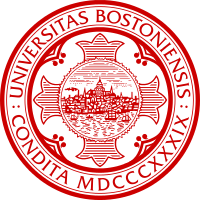 | |
| Latin: Universitas Bostoniensis | |
| Motto | Learning, Virtue, Piety[1] |
|---|---|
| Type | Private – Research |
| Established | 1839[2][3] |
| Endowment | $1.644 billion (2015)[4] |
| President | Robert A. Brown |
| Provost | Jean Morrison |
Academic staff | 3,884 (2015)[5] |
Administrative staff | 9,978 (2015)(including faculty)[5] |
| Students | 32,551 (2015)[5] |
| Undergraduates | 16,456 (2015)[5] |
| Postgraduates | 13,650 (2015)[5] |
Other students | 2,445 (2015)[5] |
| Location | Boston, Massachusetts, United States |
| Campus |
Urban 135 acres (0.55 km2) (Fenway-Charles River Campus) 80 acres (0.32 km2) (Medical campus) |
| Colors |
Scarlet and white[6] |
| Athletics | NCAA Division I – Patriot League, Hockey East |
| Nickname | Terriers |
| Mascot | Rhett the Boston Terrier |
| Affiliations | |
| Website |
www |
 | |
Boston University (most commonly referred to as BU or otherwise known as Boston U.) is a private research university located in Boston, Massachusetts. The university is nonsectarian,[7] but is historically affiliated with the United Methodist Church.[8][9]
The university has more than 3,800 faculty members and 33,000 students, and is one of Boston's largest employers.[10] It offers bachelor's degrees, master's degrees, and doctorates, and medical, dental, business, and law degrees through eighteen schools and colleges on two urban campuses. The main campus is situated along the Charles River in Boston's Fenway-Kenmore and Allston neighborhoods, while the Boston University Medical Campus is in Boston's South End neighborhood.
BU is categorized as an RU/VH Research University (very high research activity) in the Carnegie Classification of Institutions of Higher Education.[11] BU is a member of the Boston Consortium for Higher Education[12] and the Association of American Universities.
The university counts seven Nobel Laureates, twenty-three Pulitzer Prize winners, nine Academy Award winners, and several Emmy and Tony Award winners among its faculty and alumni. BU also has MacArthur, Sloan, and Guggenheim Fellowship holders as well as American Academy of Arts and Sciences and National Academy of Sciences members among its past and present graduates and faculty.
The Boston University Terriers compete in the NCAA's Division I. BU athletic teams compete in the Patriot League, and Hockey East conferences, and their mascot is Rhett the Boston Terrier. Boston University is well known for men's hockey, in which it has won five national championships, most recently in 2009.
History
| William Fairfield Warren | 1873–1903 |
| William E. Huntington | 1904–1911 |
| Lemuel H. Murlin | 1911–1924 |
| Edwin Holt Hughes (acting) | May–Sep 1923 |
| William F. Anderson (acting) | 1925–1926 |
| Daniel L. Marsh | 1926–1951 |
| Harold C. Case | 1951–1967 |
| Arland Christ-Janer | 1967–1970 |
| Calvin B.T. Lee (acting) | 1970 |
| John Silber | 1971–1996 |
| Jon Westling | 1996–2003 |
| John Silber | 2003–2004 |
| Aram Chobanian | 2004–2006 |
| Robert A. Brown | 2006 – present |
Predecessor institutions and University Charter
Boston University traces its roots to the establishment of the Newbury Biblical Institute in Newbury, Vermont in 1839, and was chartered with the name "Boston University" by the Massachusetts Legislature in 1869. The University organized formal Centennial observances both in 1939 and 1969.[13]
On April 24–25, 1839 a group of Methodist ministers and laymen at the Old Bromfield Street Church in Boston elected to establish a Methodist theological school. Set up in Newbury, Vermont, the school was named the Newbury Biblical Institute.
In 1847, the Congregational Society in Concord, New Hampshire, invited the Institute to relocate to Concord and offered a disused Congregational church building with a capacity of 1200 people. Other citizens of Concord covered the remodeling costs. One stipulation of the invitation was that the Institute remain in Concord for at least 20 years. The charter issued by New Hampshire designated the school the "Methodist General Biblical Institute", but it was commonly called the "Concord Biblical Institute."
With the agreed twenty years coming to a close, the Trustees of the Concord Biblical Institute purchased 30 acres (120,000 m2) on Aspinwall Hill in Brookline, Massachusetts, as a possible relocation site. The institute moved in 1867 to 23 Pinkney Street in Boston and received a Massachusetts Charter as the "Boston Theological Institute."
In 1869, three Trustees of the Boston Theological Institute obtained from the Massachusetts Legislature a charter for a university by name of "Boston University." These three were successful Boston businessmen and Methodist laymen, with a history of involvement in educational enterprises and became the Founders of Boston University. They were Isaac Rich (1801–1872), Lee Claflin (1791–1871), and Jacob Sleeper (1802–1889), for whom Boston University's three West Campus dormitories are named. Lee Claflin's son, William, was then Governor of Massachusetts and signed the University Charter on May 26, 1869 after it was passed by the Legislature.
As reported by Kathleen Kilgore in her book, "Transformations, A History of Boston University" (see Further Reading), the Founders directed the inclusion in the Charter of the following provision, unusual for its time:
- No instructor in said University shall ever be required by the Trustees to profess any particular religious opinions as a test of office, and no student shall be refused admission . . . on account of the religious opinions he may entertain; provided, nonetheless, that this section shall not apply to the theological department of said University.
Every department of the new university was also open to all on an equal footing regardless of sex, race, or (with the exception of the School of Theology) religion.
Early years (1870–1900)
The Boston Theological Institute was absorbed into Boston University in 1871 as the BU School of Theology.
In January 1872 Isaac Rich died, leaving the vast bulk of his estate to a trust that would go to Boston University after ten years of growth while the University was organized. Most of this bequest consisted of real estate throughout the core of the city of Boston and was appraised at more than $1.5 million. Kilgore describes this as the largest single donation to an American college or university to that time. By December, however, the Great Boston Fire of 1872 had destroyed all but one of the buildings Rich had left to the University, and the insurance companies with which they had been insured were bankrupt. The value of his estate, when turned over to the University in 1882, was half what it had been in 1872. As a result, the University was unable to build its contemplated campus on Aspinwall Hill and the land was sold piecemeal as development sites. Street names in the area, including Claflin Road, Claflin Path, and University Road, are the only remaining evidence of University ownership in this area.

Following the fire, Boston University established its new facilities in buildings scattered throughout Beacon Hill and later expanded into the Boylston Street and Copley Square area before building the Charles River Campus in the 1930s.

After receiving a year's salary advance to allow him to pursue his research in 1875, Alexander Graham Bell, then a professor at the university, invented the telephone in a Boston University laboratory.[14] In 1876, Borden Parker Bowne was appointed professor of philosophy. Bowne, an important figure in the history of American religious thought, was an American Christian philosopher and theologian in the Methodist tradition. He is known for his contributions to personalism, a philosophical branch of liberal theology.[15] The movement he led is often referred to as Boston Personalism.[16]

The university continued its tradition of openness in this period. In 1877, Boston University became the first American university to award a Ph.D. to a woman when classics scholar Helen Magill White earned hers with a thesis on "The Greek Drama."[14] Then in 1878 Anna Oliver became the first woman to receive a degree in theology in the United States, but the Methodist Church would not ordain her.[14] Lelia Robinson Sawtelle, who graduated from the university's law school in 1881, became the first woman admitted to the bar in Massachusetts.[14] Solomon Carter Fuller, who graduated from the university's School of Medicine in 1897, became the first black psychiatrist in the United States and would make significant contributions to the study of Alzheimer's disease.[14]
20th century and establishment of the Charles River campus
.jpg)
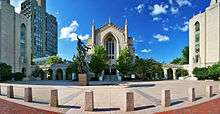
Seeking to unify a geographically scattered school and enable it to participate in the development of the city, school president Lemuel Murlin arranged that the school buy the present campus along the Charles River. Between 1920 and 1928, the school bought the 15 acres (61,000 m2) of land that had been reclaimed from the river by the Riverfront Improvement Association. Plans for a riverside quadrangle with a Gothic Revival administrative tower modeled on the "Old Boston Stump" in Boston, England were scaled back in the late 1920s when the State Metropolitan District Commission used eminent domain to seize riverfront land for Storrow Drive.[17] Murlin was never able to build the new campus, but his successor, Daniel L. Marsh, led a series of fundraising campaigns (interrupted by both the Great Depression and World War II) that helped Marsh to achieve his dream and to gradually fill in the University's new campus.[18] By spring 1936, the student body included 10,384 men and women.[19]
.jpg)
In 1951, Harold C. Case became the school's fifth president and under his direction the character of the campus changed significantly, as he sought to change the school into a national research university. The campus tripled in size to 45 acres (180,000 m2), and added 68 new buildings before Case retired in 1967. The first large dorms, Claflin, Rich and Sleeper Halls in West Campus were built, and in 1965 construction began on 700 Commonwealth Avenue, later named Warren Towers, designed to house 1800 students. Between 1961 and 1966, the BU Law Tower, the George Sherman Union, and the Mugar Memorial Library were constructed in the Brutalist style, a departure from the school's traditional architecture. The College of Engineering and College of Communication were housed in a former stable building and auto-show room, respectively.[20] Besides his efforts to expand the university into a rival for Greater Boston's more prestigious academic institutions, such as Harvard University and the Massachusetts Institute of Technology (both in Cambridge across the Charles River from the BU campus), Case involved himself in the start of the student/societal upheavals that came to characterize the 1960s. When a mini-squabble over editorial policy at college radio WBUR-FM – whose offices were under a tall radio antenna mast in front of the School of Public Relations and Communications (later College of Communications) – started growing in the spring of 1964, Case persuaded university trustees that the university should take over the widely heard radio station (now a major outlet for National Public Radio and still a B.U.-owned broadcast facility). The trustees approved the firing of student managers and clamped down on programming and editorial policy, which had been led by the late Jim Thistle, later a major force in Boston's broadcast news milieu. The on-campus political dispute between Case's conservative administration and the suddenly active and mostly liberal student body led to other disputes over B.U. student print publications, such as the B.U. News and the Scarlet, a fraternity association newspaper.
The Presidency of John Silber also saw much expansion. In the late 1970s, the Lahey Clinic vacated its building at 605 Commonwealth Avenue and moved to Burlington, Massachusetts. The vacated building was purchased by BU to house the School of Education.[21] After arriving from the University of Texas in 1971, Silber set out to remake the university into a global center for research by recruiting star faculty. Two of his faculty "stars," Elie Wiesel and Derek Walcott, won Nobel Prizes shortly after Silber recruited them.[22] Two others, Saul Bellow and Sheldon Lee Glashow won Nobel Prizes before Silber recruited them.[22]
In addition to recruiting new scholars, Silber expanded the physical campus, constructing the Photonics Center for the study of light, a new building for the School of Management, and the Life Science and Engineering Building for interdisciplinary research, among other projects.[23] Campus expansion continued in the 2000s with the construction of new dormitories and the Agganis Arena.
The 21st century
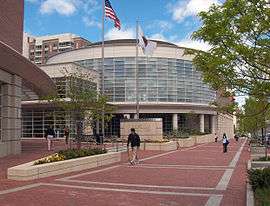
Robert Brown's presidency, which started in 2005, will seek to further the consolidation of campus infrastructure that was commenced by Case and continued by Silber. In particular, Brown has committed Boston University to investing $1.8 billion in the completion of its ten-year strategic plan, allocating new resources to inter-college opportunities for undergraduates, improving the campus's academic and residential facilities, and recruiting new faculty for the University's largest college. The strategy includes increasing the annual budget to $225 million.[24]
The cornerstone of the plan, which calls for more campus-wide collaboration, is a focus on undergraduate education, starting with an effort to encourage cross-registration among schools and colleges and to encourage undergraduate students to take full advantage of both the liberal arts and the professional programs available.[25]
Plans exist to strengthen the School of Law, the School of Management, and the College of Fine Arts, including changes to the physical plant and the hiring of additional faculty. The School of Medicine plans physical improvements, including more affordable student housing.[26]
Plans also exist to improve general student housing. The campus computer system was updated in 2009, despite the then ongoing financial crisis.[27] Plans to increase the size of the campus and improve its long, narrow shape include the purchase of air rights over the Mass Pike.[28]
Campus

Boston campuses and facilities
The University's main Charles River Campus follows Commonwealth Avenue and the Green Line, beginning near Kenmore Square and continuing for over a mile and a half to its end near the border of Boston's Allston neighborhood. The Boston University Bridge over the Charles River into Cambridge represents the dividing line between Main Campus, where most schools and classroom buildings are concentrated, and West Campus, home to several athletic facilities and playing fields, the large West Campus dorm, and the new John Hancock Student Village complex.
As a result of its continual expansion, the Charles River campus contains an array of architecturally diverse buildings. The College of Arts and Sciences, Marsh Chapel (site of the Marsh Chapel Experiment), and the School of Theology buildings are the university's most recognizable and were built in the late-1930s and 1940s in collegiate gothic style. A sizable amount of the campus is traditional Boston brownstone, especially at Bay State Road and South Campus where BU has acquired almost every townhouse those areas offer. The buildings are primarily dormitories but many also serve as various institutes as well as department offices. From the 1960s–1980s many contemporary buildings were constructed including the Mugar Library, BU Law School and Warren Towers, all of which were built in the brutalist style of architecture. The Metcalf Science Center for Science and Engineering, constructed in 1983, might more accurately be described as Structural Expressionism. Morse Auditorium, adjacent, stands in stark architectural contrast, as it was constructed as a Jewish temple. The most recent additions to BU's campus are the Photonics Center, Life Science and Engineering Building, The Student Village (which includes the FitRec Center and Agganis Arena), and the School of Management. All these buildings were built in brick, a few with a substantial amount of brownstone.
Student housing


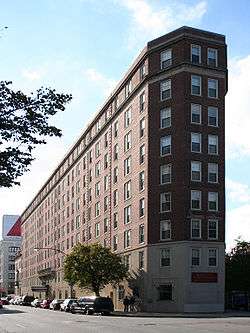
Boston University's housing system is the nation's 10th largest among four-year colleges. BU was originally a commuter school, but the university now guarantees the option of on-campus housing for four years for all undergraduate students. Currently, 76 percent of the undergraduate population lives on campus. Boston University requires that all students living in dormitories be enrolled in a year-long meal plan with several combinations of meals and dining points which can be used as cash in on-campus facilities.[30]
Housing at BU is an unusually diverse melange, ranging from individual 19th-century brownstone townhouses and apartment buildings acquired by the school to large-scale high-rises built in the 60s and 2000s.
The large dormitories include the 1,800-student Warren Towers, the largest on campus, as well as West Campus and The Towers. The smaller dormitory and apartment style housing are mainly located in two parts of campus: Bay State Road and the South Campus residential area. Bay State Road is a tree-lined street that runs parallel to Commonwealth Avenue and is home to the majority of BU's townhouses, often called "brownstones". South Campus is a student residential area south of Commonwealth Avenue and separated from the main campus by the Massachusetts Turnpike. Some of the larger buildings in that area have been converted into dormitories, while the rest of the South Campus buildings are apartments.
Boston University's newest residence and principal apartment-style housing area is officially called 33 Harry Agganis Way, StuVi2 unofficially, and is part of The John Hancock Student Village project. The north-facing, 26-story building is apartment style while the south-facing, 19-story building is in an 8-bedroom dormitory style suite. In total, the building houses 960 residents.
Aside from these main residential areas, smaller residential dormitories are scattered along Commonwealth Avenue.
Boston University also provides specialty houses or specialty floors to students who have particular interests.
All large dormitories have 24/7 security and require all students to swipe and show their school identification before entering.
Shelton Hall is rumored to be haunted by the ghost of playwright Eugene O'Neill. O'Neill lived in what was originally room 401 (now 419) while the building was a residential hotel. He died in a hospital on November 27, 1953, and his ghost is rumored to haunt both the room and the floor. The fourth floor is now a specialty floor called the Writers' Corridor.
John Hancock Student Village
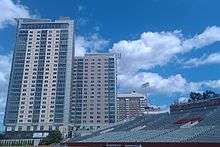
The Student Village is a large new residential and recreational complex covering 10 acres (40,000 m2) between Buick Street and Nickerson Field, ground formerly occupied by a National Guard Armory, which had been used by the University for indoor track and field and as a storage facility before its demolition and the start of construction. The dormitory of apartment suites at 10 Buick Street (often abbreviated to "StuVi" by students) opened to juniors and seniors in the fall of 2000. In 2002, John Hancock Insurance announced its sponsorship of the multimillion-dollar project.
The Agganis Arena, named after Harry Agganis, was opened to concerts and hockey games in January 2005. The Agganis Arena is capable of housing 6,224 spectators for Terrier hockey games, replacing the smaller Walter Brown Arena. It can also be used for concerts and shows. In March 2005, the final element of phase II of the Student Village complex, the Fitness and Recreation (FitRec) Center, was opened, drawing large crowds from the student body. Construction on the rest of phase II, which included 19- and 26-story residential towers was finished in fall 2009.
Other facilities
The Mugar Memorial Library is the central academic library for the Charles River Campus. It also houses the Howard Gotlieb Archival Research Center, formerly called the Twentieth Century Archive, where documents belonging to thousands of eminent figures in literature, journalism, diplomacy, the arts, and other fields are housed.
The George Sherman Union (GSU), located next to Mugar Memorial Library, provides students with a food court featuring many fast-food chains, including Panda Express, Starbucks, and Pinkberry. The GSU also provides lounge areas for students to relax or study. The basement of the George Sherman Union is home to the BU Central lounge, which hosts concerts and other activities and events.
"The Castle" located on the West end of Bay State Road is one of the older buildings on campus. The building was commissioned by William Lindsay for his own use in 1905, long before his daughter's honeymoon on the Lusitania.[31] In 1939, the University acquired the property by agreement with the city to repay all back taxes owed; these funds were raised through donations from, among others, Dr. William Chenery, a University Trustee.[32] It served as the residence of the University president until 1967, when President Christ-Janer found it too large for his needs as a residence and turned it to other uses. It is now a conference space. Underneath the Castle is the BU Pub, the only BU-operated drinking establishment on campus.[33]
The Florence and Chafetz Hillel House on Bay State Road is the Hillel House for the university. With four floors and a basement, the facility includes lounges, study rooms and a kosher dining hall, open during the academic year (including Passover) to students and walk-ins from the community. The first floor also includes the Granby St. Cafe as well as TVs and ping-pong, pool and foosball tables. The Hillel serves as a focal point for BU's large and active Jewish community. It hosts approximately 30 student groups, including social, cultural, and religious groups, and BU Students for Israel (BUSI), Holocaust Education, and the Center for Jewish Learning and Experience. It hosts a plethora of programs and speakers as well as Shabbat services and meals.[34]
Weld House, the former office of the president of Boston University, is the former home of Charles Goddard Weld, a member of the wealthy Weld family of Massachusetts. The adjoining Dunn House contains the Office of the Chancellor.[35] The current office of the president is located in the John & Kathleen Silber Administrative Center at 1 Silber Way.
Cultural life
The university is located at the junction of Fenway-Kenmore, Allston, and Brookline. In the Fenway-Kenmore area are the Museum of Fine Arts, the Isabella Stewart Gardner Museum, and the nightlife of Landsdowne Street as well as Fenway Park, home of the Boston Red Sox. Allston has been Boston's largest bohemian neighborhood since the 1960s. Nicknamed "Allston Rock City",[36] the neighborhood is home to many artists and musicians, as well as a variety of cafés, and many of Boston's small music halls.
Beyond the southern border of the campus in Brookline, Harvard Avenue offers independent and foreign films at Coolidge Corner Theatre, and author readings at the Brookline Booksmith. Other nearby cultural institutions include Symphony Hall, Jordan Hall, the main branch of the Boston Public Library in Copley Square, the art and commerce of fashionable Newbury Street, and across the Charles River, the museums, shops, and galleries in Harvard Square and elsewhere in Cambridge.
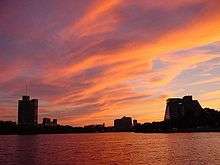
BU is home to the Huntington Theatre Company at the BU Theatre (264 Huntington Avenue), as well as Boston Playwrights' Theatre.
BU hosts campus and non-campus musical performances in the Tsai Performance Center at 685 Commonwealth Avenue, and the CFA Concert Hall at 855 Commonwealth Avenue.
Visual art works by students and by visiting artists are displayed in rotating exhibitions in the University's three galleries: the BU Art Gallery (BUAG) at the Stone Gallery, the 808 Gallery, and the Sherman Gallery, located respectively at 855, 808, and 775 Commonwealth Avenue. In addition, BU is associated with the Photographic Resource Center located at 832 Commonwealth Avenue, which mounts several exhibitions yearly, as well as special events for student and professional photographers.
Guest and visitor policies
Prior to September 2007, Boston University had a restrictive visitor policy, which limited the ability of students from different dormitories to visit each other at night. This changed when a new policy approved by Brown took effect.[37] The new policy allows for students living on campus to swipe into any on-campus dormitory between the hours of 7 am and 2 am using their ID cards. Student residents can also sign in guests with photo identification at any time, day or night. Overnight visitors of the opposite sex are no longer required to seek a same-sex "co-host".[38] However, during the week before final exams no guests are permitted in the halls overnight, and are expected to be out of the hall by 2 am.[39]
Mass transit
Most of the buildings of the main campus are located on or near Commonwealth Avenue. The Kenmore Square area of campus (including the Boston University Bookstore, Shelton Hall and Myles Standish Hall) may be accessed using the Kenmore stop on the MBTA Green Line B, C and D trains. Most of the rest of the main campus may be accessed using the B trains of the Green Line between the Blandford Street and Babcock Street stops. The #57 Bus runs from Kenmore Square along Commonwealth Avenue, and into Allston and Brighton. The MBTA Commuter Rail Framingham/Worcester Line also stops near campus at Yawkey station.
The Medical Campus is served by the #1 and CT1 crosstown buses which run along Massachusetts Avenue, as well as the #47 and CT3 crosstown buses which connect the Boston University Medical Center with the Longwood Medical Area. The Silver Line Washington Street Branch runs the entire length of the Medical Campus, one block north of most parts of the campus; it connects Boston University Medical Center with Tufts Medical Center station and downtown Boston. The nearest underground subway station is the Massachusetts Avenue station on the Orange Line, located three blocks north of the Medical Center.
The Boston University Shuttle (BUS) serves to connect the Charles River Campus, Boston University Theater, and the Medical Campus.
Sustainability
Boston University's sustainability committee is working to "reduce energy consumption and decrease waste across the campus by concentrating on four crucial areas: recycling and waste management, energy efficiency, sustainable building development and operations, and communications, education, and outreach."[40] One of the University's early steps toward creating a greener campus was implementing tray-free dining, which saved both water and cash.[40] Moving forward, BU's newly hired Director of Sustainability, Dennis Carlberg, will continue to focus the University more intensely on sustainability issues.[40]
In 2010, The Princeton Review rated BU as one of the greenest schools in the country.[41]
Other campuses
London Campus
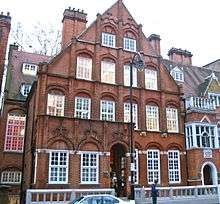
Boston University's largest study abroad program is located in London, England. Boston University London Programmes offers a semester of study and work in London through their London Internship Program (LIP), as well as a number of other specialized programs. The LIP program combines a professional internship with coursework that examines a particular academic area in the context of Britain's history, culture, and society and its role in modern Europe. Courses in each academic area are taught by selected British faculty exclusively to students enrolled in the Boston University program. Upon successful completion of a semester, students earn 16 Boston University credits. BU London Programmes are headquartered in South Kensington, London. The campus consists of the main building at 43 Harrington Gardens, as well as three nearby residences to house students. This program is open to Boston University students, as well as students at other American colleges.
Los Angeles Campus
In Los Angeles, BU has an internship program for students to study and work in the heart of the film, television, advertising, public relations, and entertainment management and law industries. The program offers three tracks from which undergraduate and graduate students can choose: Advertising and Public Relations, Film and Television, and Entertainment Management. Graduated students have the opportunity to continue their education by enrolling in the Los Angeles Certificate Program, where students can choose either the Acting in Hollywood or the Writer in Hollywood track. Courses are taught by Boston University faculty and alumni who serve as mentors in and out of the classroom. Upon successful completion of a semester students will earn 16 Boston University credits. Students who successfully complete the Los Angeles Certificate Program will receive 8 Boston University credits and a certificate from Boston University College of Fine Arts or College of Communication.
Paris Campus
The Paris Center runs several programs, the largest of which is the Paris Internship Program dating from 1989. Students take language and elective courses with French faculty at the BU Paris Center, then are placed in internships with French businesses and organizations in the area. Students live with host families or in a dormitory for the extent of the semester. Boston University Paris also organizes exchange programs with the business school Paris Dauphine University and a yearlong program with the Institut d'études politiques de Paris (Sciences Po).[42]
Washington, DC Campus
In Washington, D.C., BU has internship, journalism and management programs. Students study in the University's building on Massachusetts Avenue in Dupont Circle and take advantage of the city by interning at different locations. In 2011 the University completed construction of a new, multistory residence to house students in the program featuring touch-less entry cards for security and suites with communal kitchens, right next to the Woodly Park/Zoo Metro stop.[43] The Multimedia and Journalism program allows students to act as Washington, D.C. correspondents for newspapers and television stations across the Northeast and New England while interning at major news outlets in the city, as well as at many PR internships in politics, government and public affairs. Internship opportunities are also offered in a wide variety of sectors for students enrolled in other BU Study Abroad Washington programs.
Sydney Campus
In Sydney, BU has internship, management, film festival, travel writing, engineering, and School of Education programs that vary based on semester. Around 150 students live in the University's building in Chippendale developed by Tony Owen Partners.[44][45] The building uses "fissures to provide maximum solar access to bedrooms as well as natural ventilation throughout the building."[46] The building opened in the beginning of 2011 and features underground classrooms, a lecture hall, office space, library, and a roof patio.
Other internship and study abroad opportunities are available through the Study Abroad office.[47]
Brussels Campus (closed)
Boston University Brussels ceased operations in December 2013. Officially named the Boston University Brussels Graduate Center, and also known as BUB, was part of Boston University's Metropolitan College (MET), one of seventeen degree granting colleges that make up Boston University. In 1972 Boston University became the first major American university to offer graduate business management degrees in Europe with the opening of its campus in Brussels, Belgium.[48] Due to its location in the capital of Europe, home to the European Union and NATO, the school placed a strong emphasis on international business, and the student body comprised a diverse range of nationalities and cultures.
Dubai Campus (closed)
The BU-Dubai dental collaboration, the Boston University Institute for Dental Research and Education–Dubai (BUIDRE), ceased operations in July 2012. The University opened the dental school in Dubai, UAE in 2007, and admitted its first group of students in July 2008. It graduated its second and final class of residents in June 2012. "Dubai Healthcare City is a free medical zone within the Emirate of Dubai, has been developed as a world-class, academic medical community, which will be developed around the Harvard Medical School Dubai Center, Boston University Institute for Dental Research and Education, and a major university hospital", according to Kathi Ferland, director of admissions at GSDM.[49]
Admissions/demographics
For the freshman class admitted the fall of 2016, the university received 57,416 applications, admitting approximately 29% to create a class of approximately 3,500 students (n.b. not all students admitted choose to attend).[50] The admitted freshmen class had an average SAT score of 2067, an average ACT score of 31, ranked in the top 8% of their high school class, and had an average overall grade of an A-.[50]
Based on currently enrolled student responses within the university student database 50.6% white, 14% Asian, 11.6% international students, 8.6% Hispanic, and 3.2% black. The international community at Boston University is 18% Chinese, 12% Korean, 11% Indian, 6% Taiwanese, 6% Canadian, 4% Japanese, 3% Turkish, 2% Thai, 2% Saudi Arabian, and 2% Mexican. Of the 7% of students who are international students, 26% are pursuing undergraduate degrees and 47% are pursuing graduate degrees, with the remaining 27% engaged in other educational activity.[51] BU also has the second highest number of Jews of any private school (after NYU) in the country with between 3,000[52][53] and 4,000,[54] or roughly 15%[53] identifying as Jewish.
The plurality of registrants were from Massachusetts (19%), followed by New York (16%), New Jersey (9%), California (8%), Connecticut (4%), Pennsylvania (4%), and Texas (2%).[55]
Academics
Colleges and schools
| College/School | |
| School of Theology | |
| School of Medicine | |
| School of Law | |
| College of Arts and Sciences | |
| Graduate School of Arts and Sciences | |
| College of Health and Rehabilitation Sciences (Sargent College) | |
| Questrom School of Business | |
| School of Education | |
| School of Social Work | |
| College of Communication | |
| College of General Studies | |
| College of Fine Arts | |
| Henry M. Goldman School of Dental Medicine | |
| College of Engineering | |
| Metropolitan College | |
| School of Public Health | |
| School of Hospitality Administration | |
| Arvind and Chandan Nandlal Kilachand Honors College | |
| Frederick S. Pardee School of Global Studies | |
Boston University offers bachelor's degrees, master's degrees, and doctorates, and medical, dental, and law degrees through its 18 schools and colleges. The newest school at Boston University is the Frederick S. Pardee School of Global Studies (established 2014), and the newest name is the Questrom School of Business (renamed in 2015).
Each school and college at the university has a three letter abbreviation, which is commonly used in place of their full school or college name. For example, the College of Arts and Sciences is commonly referred to as CAS, the Questrom School of Business is QSB, the School of Education is SED, etc.
The College of Fine Arts was formerly named the School of Fine Arts (SFA). The College of Arts and Sciences (CAS) was formerly named the College of Liberal Arts (CLA). The College of Communication was formerly named the School of Public Communication (SPC). The Questrom School of Business (QSB) was formerly known as the School of Management (SMG),[56] and the College of Business Administration (CBA) prior to that. The College of General Studies (CGS) was formerly named the College of Basic Studies (CBS).
The Mental Health Counseling and Behavioral Medicine (MHCBM) Program at Boston University School of Medicine offers a master's degree for students who wish to become licensed to practice as a mental health counselor. The program adheres to educational guidelines and standards of the American Counseling Association (ACA), American Mental Health Counselors Association (AMHCA), and the Council for Accreditation of Counseling and Related Educational Programs (CACREP), which is an independent agency recognized by the Council for Higher Education Accreditation. The MHCBM Program is the only counselor education program in the entire United States that is housed in a medical school for solely training students in clinical mental health counseling to treat clients and patients with a mental disorder via counseling and psychotherapy.
Rankings
| University rankings | |
|---|---|
| National | |
| ARWU[57] | 39 |
| Forbes[58] | 79 |
| U.S. News & World Report[59] | 39 |
| Washington Monthly[60] | 157 |
| Global | |
| ARWU[61] | 75 |
| QS[62] | 89 |
| Times[63] | 64 |
| U.S. News & World Report[64] | 32 |
U.S. News & World Report ranks Boston University tied for 39th among national universities and 32nd among global universities for 2017.[65] Boston University was also ranked 10th among public health graduate schools, 12th among social work schools, tied for 20th among law schools, tied for 29th among medical schools (research), 35th among engineering schools, tied for 41st among business schools, and 45th among education schools.[66]
In 2014, BU's QSB undergraduate (business) program was ranked 23rd by Bloomberg Businessweek.[67]
QS World University Rankings in 2016 ranked Boston University 89th overall in the world.
Times Higher Education ranked Boston University 64th in the world for 2016-17.
The Academic Ranking of World Universities ranks Boston University 39th in the United States, and 75th in the world, in its 2016 list.
Newsweek (International Edition), in its list of the Top 100 Global Universities, ranked Boston University the 35th in the United States, and 65th in the world.[68]
The Economics department at Boston University is ranked 20th in the world as of February 2016. [69] Additionally, U.S. News & World Report ranks the program in economics 24th in the U.S. for 2017.[66]
The Biomedical Engineering graduate and undergraduate programs are ranked 7th and 8th respectively in the nation and rising by U.S. News & World Report. The undergraduate program is also the sixth-largest ABET-accredited program in the nation.[70]
Additionally, all of the professional graduate programs in the Boston University College of Health and Rehabilitation Sciences: Sargent College rank within the top 8% in the country. The Occupational Therapy Program ranked 2nd out of 156 programs; the Physical Therapy Program ranked 16th out of 201 programs; and the Speech-Language Pathology Program ranked 21st out of 250 programs.[71]
The College of Communication journalism and communication programs are highly ranked nationally with its film program ranked 11th by The Hollywood Reporter in 2013.[72]
Business Week ranks Boston University's MBA program 38th, and its undergraduate business program 18th.[73]
The Economist ranks Boston University School of Management 42nd among global MBA programs in 2010.[74]
The Financial Times ranks Boston University's MBA program 68th in the world.[75]
Quantnet ranks Boston University's Mathematical Finance program 14th in the world.[76]
The Chronicle of Higher Education places the Boston University School of Social Work as sixth in the nation for research productivity by faculty.[77]
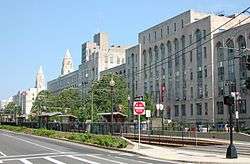
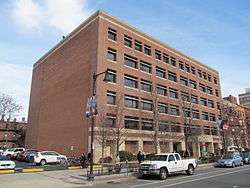
The Center for Measuring University Performance ranks Boston University among the top 50 research universities in the country.[78]
BU is one of 96 American universities receiving the highest research classification ("RU/VH") by the Carnegie Foundation.[11]
Grade deflation
The independently run student newspaper at Boston University, The Daily Free Press, as well as The New York Times,[79] have published articles exploring the existence of grade deflation. The Times discovered that administrators have suggested to faculty members deflated ideal grade distributions. Though an article in the staff's BU Today asserted that "the GPAs of BU undergrads and the percentage of As and Bs have both risen over the last two decades", The New York Times has found BU grades rising more slowly with respect to many other schools.
In 2004, the average GPA of a BU undergraduate was 3.04,[80] compared to the averages of 3.35 for Boston College, (2007)[81] 3.48 for Amherst College, (2006)[82] 3.41 for New York University (2002)[83] and 3.43 for Harvard University (2004).[84]
About 81 percent of all grades earned in either the A or B range (75% in the B range). The article went on to note that although the university attempted to curb grade inflation and inconsistency in the late 1990s, both the percentage of As and GPAs have been rising since. They attributed the grade deflation not to teachers' grading policies, but to the increasing quality of each incoming class which leads to more top grades.[85]
Journals and publications
Boston University is home to several academic journals and publications. The School of Law hosts six nationally recognized law journals, including the Boston University Law Review, American Journal of Law and Medicine, Review of Banking & Financial Law, Boston University International Law Journal, Journal of Science and Technology Law, and Public Interest Law Journal.[86] The School of Education houses The Journal of Education, which is the oldest continuously published journal in the field of education in the country.[87] In the College of Arts and Sciences, Studies in Romanticism is housed at the Department of English[88] and The Journal of Field Archeology is housed at the Department of Archeology.[89][90] The Department of History is affiliated with The Historical Society, which publishes The Journal of the Historical Society and Historically Speaking.[91] The American Journal of Media Psychology and the Public Relations Journal are currently edited by professors at the College of Communication,[92] which is also home to the New England Center for Investigative Reporting, which generates numerous publications yearly.[93] The university also offers its undergraduates the opportunity to publish exceptional work in WR: Journal of the CAS Writing Program.[94]
Special academic programs
Core Curriculum
.jpg)
Offered in the College of Arts and Sciences, the Core Curriculum offers an intensive great books program for any incoming freshmen who choose to participate. Occupying two classes a semester during freshman and sophomore years, the program has four humanities sections which start with the Epic of Gilgamesh and work their way through Plato, Aristotle, Aeschylus, Machiavelli, Shakespeare, Milton, Dante, Bach and many more. The Social Sciences part of the program includes Hobbes, John Locke, Rousseau, Adam Smith, Marx, and continues through contemporary works. Lastly, the science aspect of the program deals with major ideas such as big bang theory, evolution, quantum mechanics and more. Ultimately, the program seeks to combine science, math, humanities, art, and the social sciences into a cohesive program to give students insight into their world and help them become more refined writers and scholars.
University Professors Program
The University Professors Program (UNI) was an interdisciplinary program that allowed students to pursue a broad range of academic interests. With a student to faculty ratio of 4:1, UNI offered students a broad education in a more personalized atmosphere. Students took a common, intimate, "Core" program consisting of liberal arts courses taught by University Professors in small seminar settings. They then worked closely with an advisor to craft a course of study which led them to an interdisciplinary degree, culminating in a senior thesis. Based upon the report of an academic review committee, a new University-wide honors program was developed and the UNI program was replaced by the University Honors College.[95]
Kilachand Honors College
The University Honors College matriculated its first class in 2010. In 2011, it was renamed Arvind and Chandan Nandlal Kilachand Honors College following a $25 million donation from Rajen Kilachand; the largest donation in the history of the University. The Kilachand Honors College is a university-wide community of faculty and students dedicated to preserving, renewing, and rethinking classic ideals of liberal education: love of learning, intellectual curiosity, self-discovery, empathy, clarity of thought and expression. It rests on three pillars: an integrated, four-year curriculum; an extensive series of co-curricular events that include site-visits to leading cultural institutions as well as talks and readings by leading figures in the arts, sciences, and professions; and, finally, a "living and learning" community that offers students the personal atmosphere of a small liberal arts college and fosters responsibility and citizenship.[96]
Trustee Scholars Program
Though not an academic program per se, the Trustee Scholars program is a merit-based, full-tuition scholarship for top students. Beyond the financial benefits, Trustee Scholars are also treated to special lectures by distinguished professors. Additionally, Trustee Scholars can live in a designated residence on campus, Boyd Hall.
Boston University Academy
Boston University Academy is a private high school operated by Boston University. Founded in 1993, the school sits within the university's campus and students are offered the opportunity to take university courses.
Student life
Student publications
Despite a Student Activities policy which prohibits student-run publications from receiving University funding for printing costs, student journals continue to thrive at Boston University as department-sponsored publications, edited by students under the supervision of faculty and staff advisors. The coordinator for undergraduate publications, responsible for acquainting new editors with University guidelines and directing publications staff to campus production and financial resources, has been Zachary Bos of the Core Curriculum since 2006.
Although officially and entirely independent from the University, The Daily Free Press (often referred to as The FreeP), is the campus student newspaper, and the fourth largest daily newspaper in Boston. Since 1970, it has provided students with campus news, city and state news, sports coverage, editorials, arts and entertainment, and special feature stories. The Daily Free Press is published every regular instruction day of the University year and is available in BU dorms, classroom buildings and commercial locations frequented by students.
The Boston Political Review is BU's premier on-campus political magazine. Founded in the spring of 2014, the BPR publishes an online edition every month, with a range of subjects including national, global, and local politics as well as sections on lobbying, social issues, and economics. The BPR prints their highlighted articles and new material once every semester in a free print magazine that is distributed around campus. Their mission is to offer Boston University students, alumni, staff, and faculty the chance to read a balanced political magazine that offers arguments from all points of view on the political spectrum.[97]
Founded in spring 2009, THE BU BUZZ is Boston University's lifestyle magazine on news and happenings on and off campus. Sections include Campus, City, Arts, Food, Music, Fashion, Sports, and Abroad. In the Spring of 2013, the Buzz rebranded as an online magazine, ceasing its bi-annual publication to allow for weekly and daily updated articles, including the addition of new sections and new interactive features. In the Fall of 2013, the staff, run entirely by students, looks to incorporate a broadcast segment. Unlike other BU publications, the Buzz has emerged as Boston University campus brand, hosting press events, public relations groups and looking to apply magazine 3.0 tactics to the journalism community.
BU's The Quad is an independent, student-run online magazine started in the fall of 2009. The magazine features articles and columns on topics including campus news, television, food, politics, and music.[98]
Synapse is the Boston University Undergraduate Science Magazine and is published online every semester. The "Science" focus is on many disciplines ranging from life sciences to physical sciences, engineering to mathematics, and finance to economics. The magazine is peer and faculty reviewed, and is advertised with routine, campus-wide distribution of pamphlets highlighting featured articles. Synapse was first published in the spring of 2009 and continues to publish articles each semester.[99]
The Brownstone Journal is the longest-running campus publication, having been publishing undergraduate research, scholarly articles and essays, and literary work in translation, since 1982. The Brownstone is currently sponsored by the Undergraduate Research Opportunities Program, but was originally a departmental publication of the University Professors Program. The staff operates from their offices in the former yearbook space in the basement of 10 Lenox Street, beneath the editorial offices of Bostonia.
The literary arts magazine Clarion has been printed since 1998. The first issue, titled "?", was published by the group Students for Literary Awareness with the sponsorship of the Department of English; subsequent issues have been issued by the BU Literary Society. Burn Magazine is a younger literary magazine, published biannually.
The inaugural issue of Boston University's newest literary magazine, Coup d'État, was published in January 2014 by the Boston University Literary Society, with the support of the Department of English. It is published biannually, taking submissions both students of BU and nationally.[100]
In 2006, the first issue of Pusteblume journal of translation was published by a group of former and current students of a co-curricular poetry seminar run by Professor George Kalogeris of the Core Curriculum. The journal, jointly sponsored by the Department of Romance Languages, the Department of Modern Languages and Comparative Literatures, and the Core Curriculum, publishes literature in translation and articles concerning translation.
The Journal of the Core Curriculum has been published continuously since 1992 by the College of Arts and Sciences Core Curriculum. Produced by a student editorial staff with the guidance of a faculty advisor, the very interdisciplinary Core Journal publishes academic prose, literary imitations, fictitious encounters between figures from the 'great works', original poetry and creative writing, essays, artwork, translations, and even—in Vol. XVI, Spring 2007—original musical compositions. The Back Bay Review is a student-run journal of critical writing.
Arché is an annual journal of undergraduate work in philosophy, whose first issue was released in the summer of 2007. It is sponsored by the Department of Philosophy and published by the Undergraduate Philosophy Association.
The International Relations Review began in 2009 as a subsidiary publication of The Boston University International Affairs Association. Entirely student-run, The IR Review is an independent scholarly journal publishing articles from all areas in international affairs. The goal of The IRR is to unite the many talents and experiences within BU's vast department of international relations.
Even more independent, The Student Underground, focuses on alternative political and cultural activity. Since 1997, issues have been published roughly monthly by a "not-for-profit collective" composed mostly of BU students. In 2007, the paper began operating under the name The Boston Underground; the original editorial focus on campus issues has over the years weakened as the founding editors graduated from BU or left Boston altogether.
The Sam Adams Review was a short-lived monthly student newspaper "providing news for the American Spirit," geared toward a conservative readership. Its staff was not officially recognized as a registered student activity group but, like the Underground, was entirely student-run.
Boink was launched in February 2005 by a group of undergrads led by Alecia Oleyourryk, who was then a senior at the College of Communications. The magazine features BU students posing nude, as well as articles on sexuality. At the time of its first issue, the Dean of Students issued a statement explaining that "the University does not endorse, nor welcome, the prospective publication Boink." The magazine was then, and remains, unaffiliated with the University.
In September 2005, the student paper The Source began to appear weekly, and was characterized by a predominance of arts and entertainment coverage. No new issues were printed after November 2006, and it appears the publisher Greenline Media is now defunct.
BU Culture Shock is the official blog of the Howard Thurman Center, Boston University's multicultural center. It is dedicated to free expression and open discussion. Culture Shock is notable for its coverage of the 2011 Boston University Union election, inviting contributions from candidates along with other students.

Community Service Center
The Boston University Community Service Center (CSC) is student initiated in solidarity with neighborhoods, community partner organizations, and civic leaders. Each semester, the CSC facilitates education, reflection, and service through more than 13 volunteer programs related to opportunities of local, national, or global concern, including hunger and food justice, children and education, elders, disabilities, homelessness and affordable housing, human rights, public health, LGBTQ+ communities, and the environment.
The CSC also runs two immensely popular one-week programs. During the First-Year Student Outreach Project (FYSOP), upperclassmen lead groups of freshmen in volunteer activities throughout Boston before the start of first semester. For Alternative Service Breaks (ASB), hundreds of students travel by 12-passenger van, bus, and airplane to locations throughout the country to partner with communities and community organizations.
Graduate workshops
Willing Suspension Productions provides graduate English students the opportunity to present rare Early modern drama before a Boston audience. The program was founded in 1993 and produces one play per year.
ROTC
The Reserve Officer Training Corps (ROTC) at BU traces its origins back to August 16, 1919 when the U.S. War Department stood up the Students' Army Training Corps at Boston University, the predecessor to the current Army ROTC program.[101] Today, BU is one of twenty five colleges and universities in the country to host all three ROTC programs – Army, Navy, and Air Force. Students wishing to be commissioned into the Marine Corps study as Navy Midshipmen.
Honor Societies
Alpha Phi Sigma - Nu Mu Chapter
Alpha Phi Sigma, the national criminal justice honor society, recognizes academic excellence in undergraduate and graduate criminal justice students, as well as Juris Doctor (JD) students, inducting new members twice yearly. The goals of Alpha Phi Sigma are to honor and promote academic excellence, community service, and educational leadership and unity. The society was originally founded in 1942 at Washington State University. The Nu Mu chapter was chartered May 2012 at Boston University. Alpha Phi Sigma is the only criminal justice honor society certified as a member of the Association of College Honor Societies and affiliated with the Academy of Criminal Justice Sciences.[102]
Other clubs and activities
- The Boston University Dear Abbeys is an acclaimed All-Male student a cappella group. In 2005, they won the International Championship of Collegiate A Cappella, a prestigious nationwide tournament for collegiate a cappella groups.
- Boston University Bhangra is one of the most well-known co-ed collegiate Bhangra dance teams.[103] The team was founded in 1999 by a few Bhangra fanatics who wanted to spread the culture of Punjab through this traditional North Indian dance. With performances on campus, as well as first place winnings at nationally ranked competitions such as Boiler Bhangra 2013 & 2014, Srujan 2014, and Muqabla 2014, BU Bhangra continues to spread its name across the nation.
- Boston University Jalwa is a premier award-winning co-ed Bollywood Fusion dance team specializing in Hip-hop, Bollywood, Bhangra, Contemporary. Boasting many award winning performances, they've won Muqabla-NNR 2011, placed as Runners-Up at Muqabla-NNR 2012 and A-Town Showdown 2012, along with 2 recent appearances at the National Championship for Filmi-Fusion Dance in 2011/2012 (Bollywood America). More notably, they are the 3-time winners of So You Think BU Can Dance (2011-2013). They remain to be one of the more prominent Filmi-Fusion dance teams of the hundreds that currently exist in the nation today.
- Boston University[104] is one of the 22 nationwide college sites where there is a branch of Peer Health Exchange. Peer Health Exchange trains college students to become PHE Health Educators in neighboring public high schools that lack funding for health education. Health Educators teach the following topics in ninth grade classrooms: Decision-Making and Communication I, Sexual Decision-Making, Pregnancy Prevention, Sexually Transmitted Infections & HIV, Healthy Relationships, Abusive Relationships, Rape & Sexual Assault, Nutrition & Physical Activity, Tobacco, Alcohol, Drugs, Mental Health, and Decision-Making and Communication II.
- Boston University Curling Club was founded in 2006. They are a club sport with the goal of teaching and fostering the sport for the BU community. The club competes in many tournaments with other schools such as Harvard, MIT, Rochester, and many others. In 2013 BU Curling competed in the College Curling National Championship and placed 4th.[105]
- Boston University Stage Troupe is the University's oldest and largest performing arts group. Open to undergrads not majoring in theater, the group performs many shows a year, and also hosts special events, some of which are coordinated with the Dean of Students.
- The Boston University Debate Society regularly competes on the American Parliamentary Debate Association debate circuit. During the 2010–11 season, BUDS fielded debaters who won both "Team of the Year" distinction as well as the 2011 National Championship at West Point, NY. The team hosts an unopposed national tournament on campus each spring, with nearly every APDA college represented.
- The Boston University Figure Skating Club is a team of students who figure skate and ice dance, and a fully fledged member of the United States Figure Skating Association. It is the reigning two-time U.S. National Intercollegiate Team Champion. In addition, the "Boston University Terrierettes" compete in Collegiate Synchronized skating, and have routinely placed in the top ten at the United States Synchronized Team Skating Championships.
- The Boston University International Affairs Association (BUIAA) is the evolution of the Boston University Model United Nations Association (BUMUNA), which was founded in 1973. This club also hosts two conferences annually, one for high school students and one on the collegiate level. BosMUN,[106] BUIAA's high school conference, hosts over 1,000 students annually from all across the globe. Last year, schools came from China, Guatemala, and Canada. BarMUN[107] (Boston Area Model United Nations Conference) is BUIAA's college level conference. BarMUN stands apart from other college conference in that the conference is a full-scale simulation, ranging from 4 to 8 committee joint crises.
- The Hug Don't Hate grassroots peace-building campaign was founded in 2006 at Boston University with the mission of creating lasting peace through happiness, understanding and respect. All of Hug Don't Hate's activities are focused on helping individuals find common ground. The activities are divided into 4 branches: 'Free Hug Fridays', 'Urban Smiles', 'Connective Kindness' and 'BUNITED'. Hug Don't Hate is also currently expanding to different locations.
- The Boston University Crafts for Charity Club is an organization of students which creates crafts for local charities.
- The Greek community on BU's campus consists of ten sororities (ten Panhellenic chapters), ten fraternities (seven Inter-Fraternity Council chapters) and recently created Multicultural Greek Council (four fraterneties and one sorority).[108] Greek life on campus became shrouded in controversy in the early 2010s, with a number of high-profile incidents including hazing and a student death. Spring 2012 saw multiple hazing incidents. In March, the sorority Sigma Delta Tau was suspended by the university for alcohol-related hazing.[109] In April 2012, fourteen BU students were charged with hazing, assault and battery, and failure to report hazing in connection with an alleged hazing of pledges to Alpha Epsilon Pi, a fraternity not recognized by the University.[110] In March 2013, a male freshman died after drinking a lethal amount of alcohol at a Sigma Alpha Mu fraternity party.[111] The university suspended the officially-sanctioned fraternity in response.
- The Boston University India Club is the University's largest student-run organization. Open to students of all ethnic backgrounds, the club sponsors cultural shows, performances and activities that showcase South Asian culture. BUIC also hosts and organizes the annual GarbaFest Competition, a garba raas competition.
- Lambda Chi Alpha (ΛΧΑ), a member of the North-American Interfraternity Conference (NIC) and one of the largest men's general fraternities in North America, was founded by Warren A. Cole, while he was a student at Boston University, on November 2, 1909.
- Delta Delta Delta (ΔΔΔ) was founded at Boston University on Thanksgiving Eve, 1888. Sarah Ida Shaw, later known as Ida Shaw Martin, founded Tri Delta without the assistance of a men's fraternity, a unique accomplishment for her time.
- Sigma Kappa (ΣΚ) was founded at Boston University in 1904 when Elydia Foss of Alpha Chapter transferred to Boston and founded the Delta chapter with a group of ladies who refused to join any other groups on campus. Elydia took the steps to make Sigma Kappa a national sorority and helped Sigma Kappa join the National Panhellenic Conference, which was called the Interfraternity Conference at the time.[112]
- Gamma Phi Beta (ΓΦΒ) Delta Chapter at Boston University was founded in 1887. As the Delta Chapter, Gamma Phi Beta is the fourth oldest chapter in the US. In 2011, the Delta Chapter celebrated its 125th Anniversary at Boston University.
- The College of Arts and Sciences (CAS) Dean's Hosts are a premier student volunteer organization where members serve as liaisons between CAS students and faculty members. Most notably, CAS Dean's Hosts along with CAS Student Government throw the Top of the Hub formal in downtown Boston annually.
- The "Boston University Soccer Club" is an athletic-based club that allows members of the BU community to participate in a variety of soccer-related events ranging from pick-up futsal games at the Fitness and Recreation Center, to philanthropic fundraising matches such as the annual "Lose the Shoes" charity tournament, from which all the proceeds go to the GrassrootSoccer campaign. The motto of the club is: "Unifying diversity through the love of the world's beautiful game."
- CAS Student Government is the University's largest individual student government group. Each year they work with the administration of the College of Arts and Sciences to deal with multiple student affairs issues within CAS. They also program many events for the students of CAS including: Celtics Night, Coffee at Finals, Ice Skating at Frog Pond, Senior Reception, and many more.
- Boston University offers close to 500 student organizations on campus.
Athletics
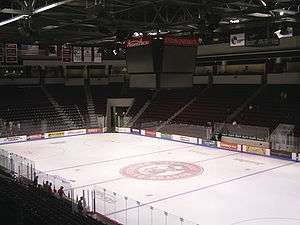
Boston University's NCAA Division I Terriers compete in men's basketball, cross country, golf, ice hockey, rowing, soccer, swimming, tennis, track, lacrosse, and wrestling, and in women's basketball, dance, cross country, field hockey, golf, ice hockey, lacrosse, rowing, soccer, softball, swimming, tennis, and track. Boston University athletics teams compete in the Patriot League, Hockey East, and Colonial Athletic Association conferences, and their mascot is Rhett the Boston Terrier. As of July 1, 2013, a majority of Boston University's teams will compete in the Patriot League.[113] On April 1, 2013, the university announced it would cut its wrestling program following the 2013-14 season.
The Boston University men's hockey team is the most successful on campus, and is a storied college hockey power, with five NCAA championships, most recently in 2009. The team was coached by hall-of-famer Jack Parker for 40 seasons, and is a major supplier of talent to the NHL, as well as to the 1980 U.S.A. Olympic Gold Medal-winning men's hockey team. The Terriers have won 30 Beanpot titles, more than any other team in the tournament, which includes Harvard University, Boston College, and Northeastern University.[114] Boston University also won a game in 2010 against Boston College at Fenway Park by a score of 3–2, played a week after the NHL Winter Classic.[115]
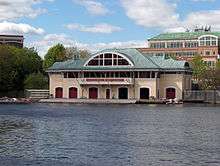
BU has also won two national championships in women's rowing, in 1991 and 1992.
Boston University recently constructed the new Agganis Arena, which opened on January 3, 2005 with a men's hockey game between the Terriers and the University of Minnesota Golden Gophers. The arena also hosts non-sporting events, such as concerts, ice shows, and other performances.
Boston University disbanded its football team in 1997. The university used the nearly $3 million from its football program to build the multimillion-dollar John Hancock Student Village and athletic complex. The university also increased funding to women's athletic programs. "By implementing the total plan, we can achieve a much more balanced set of sports programs for both men and women, which is consistent with the philosophy underlying Title IX," said former BU athletic director Gary Strickler.[116]
Club sports
Boston University students also compete in athletics at the club level. Thirty six club sports are recognized by the university, including: Synchronized Skating, Baseball; Inline Hockey; Men's Ice Hockey; Men's Volleyball; Women's Volleyball; Snowboard; Men's Ultimate Frisbee and Women's Ultimate Frisbee; Kung Fu; Fencing; Rugby Football; Synchronized Swimming; Cheerleading; Table Tennis; Women's Water Polo; Men's Water Polo; Women's Rugby; Alpine Ski Racing; Snowboarding; Cycling; Badminton; Ballroom Dance; Figure Skating; Golf; Gymnastics; Jiu Jitsu; Kendo; Shotokan Karate; Sailing; Taekwondo; Triathlon; Dance Theater Group; Squash, Equestrian, and Men's Club Football.
The BU Dinghy Sailors are among the most prestigious sailing teams in college sailing. They have won 7 Collegiate National Championships, most recently in 1999. They have also had 3 team members graduate as "College Sailor of the Year."[117] Notable alumni of the team include Ken Read, skipper for PUMA Ocean Racing in the Volvo Ocean Race, and 2012 US Sailing Rolex Yachtsman of the Year nominee, John Mollicone.[118]

The BU Inline Hockey Team advanced to the NCHRA Tournament in 2001, 2002, and 2003. The team advanced all the way to the Final Four in 2001.
Both Men's and Women's Intervarsity Table Tennis Teams have attended the National Collegiate Table Tennis Tournaments and ranked as high as the top 10 nationwide.
The BU Figure Skating Team won the 2009 Intercollegiate National Figure Skating Championships held in Colorado Springs.[119]
Notable alumni and academics
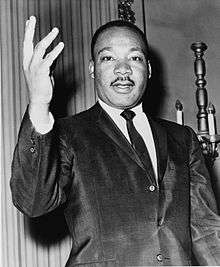

Over the course of its history, a number of people associated with Boston University have become notable in their fields. Affiliates of Boston University have won seven Nobel prizes. With over 342,000 alumni, Boston University graduates can be found around the world.[5] American Civil Rights Movement leader Martin Luther King, Jr., who earned his doctorate in systematic theology at BU in 1955, is the university's most famous graduate. After gaining prominence by advocating nonviolent resistance to segregation, he won the 1964 Nobel Peace Prize.[120] Howard Thurman, the Dean of Marsh Chapel, influenced King's embrace of nonviolence.[121] Three other alumni hold special historical importance: Rebecca Lee Crumpler was the first African-American woman and Charles Eastman (first named Ohiyesa) the first American Indian to be certified as doctors, and Helen Magill White was the first woman in the U.S. to earn a PhD.
Mathematics and sciences

Among the most famous of Boston University scientists is Alexander Graham Bell, the inventor of the telephone who conducted many of his experiments on the BU campus when he was professor of Vocal Physiology and Elocution.[122] In Boston, Bell was "swept up" by the excitement engendered by the many scientists and inventors residing in the city. In 1875, the university gave Bell a year's salary advance to allow him to pursue his research. The following year, he invented the telephone in a Boston University laboratory.[14] In the twenty-first century, the university has become a pioneering center for synthetic biology thanks to the work of James Collins. Collins and co-workers also discovered that sublethal levels of antibiotics activate mutagenesis by stimulating the production of reactive oxygen species, leading to multidrug resistance.[123] This discovery has important implications for the widespread use and misuse of antibiotics.
Other notable Boston University scientists include Sheldon Lee Glashow, winner of the 1979 Nobel Prize in Physics, Daniel Tsui, winner of the 1998 Nobel Prize in Physics, and Osamu Shimomura, winner of the 2008 Nobel Prize in Chemistry.[124]
Humanities, music, and art
Numerous actors trained at Boston University, including Faye Dunaway, Alfre Woodard, Jason Alexander, Ginnifer Goodwin, Marisa Tomei, Emily Deschanel, Viola Léger, Julianne Moore, Uzo Aduba, Paul Michael Glaser and Geena Davis. Notable musicians include Taiwanese composer Wen-Pin Hope Lee, American composer Scott Perkins,[125] and Andre de Quadros.[126] Folk singer Joan Baez studied at the university. Painters who trained at BU include Susan Louise Shatter, Domenic Cretara, and Franz Kline. Abstract painter John Walker heads the university's graduate painting program.[127]
Literature
Two U.S. Poet Laureates have taught at Boston University: Robert Lowell and Robert Pinsky.[124] During John Silber's tenure as president, he recruited two Nobel Prize-winning literary figures to the university's faculty: Elie Wiesel, winner of the 1986 Nobel Peace Prize, and Saul Bellow, winner of the 1976 Nobel Prize in Literature.[124] Another Nobel Prize winner in the English Department in the twentieth century was Derek Walcott, winner of the 1992 Nobel Prize in Literature.[124] Alumni of the university have earned over thirty Pulitzer Prizes.[128] Other writers associated with the university include Bob Zelnick,[129] executive editor of the Frost-Nixon interviews, historian Andrew Bacevich,[130] Ha Jin, Pulitzer Prize winner Jhumpa Lahiri, and Isaac Asimov.[131] In 1986, literary critic Christopher Ricks, who W.H. Auden called "exactly the kind of critic every poet dreams of finding," joined the university's faculty and founded the Editorial Institute with Geoffrey Hill.[132] Controversial historian Howard Zinn taught in the political science department for many years.[133] Journalist Thomas B. Edsall and playwright Eliza Wyatt graduated from Boston University.[134]
Politics
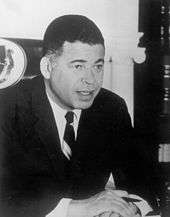
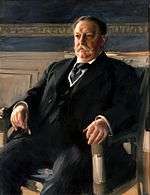
Boston University counts eleven current or former governors of U.S. states, seven United States senators, and 32 members of the United States House of Representatives among its alumni. Notable Boston University alumni in American politics include former United States Senator Edward Brooke, the first popularly elected African-American senator, former Defense Secretary William Cohen, current U.S. Ambassador to China Gary Locke, former Senator Judd Gregg, former Massachusetts Attorney General Martha Coakley, former Second Lady Tipper Gore, and the former First Vice President of the Federal Reserve Bank of Boston Earle O. Latham. Former President William Howard Taft lectured on Legal Ethics at the university's law school from 1918 to 1921.[135] After leaving politics in 2014, former Boston mayor Thomas Menino was professor of the practice of political science at the university until his death later in the year.[136] In international politics, Daniyal Aziz is a Pakistani politician affiliated with the Pakistan Muslim League (N) who is currently a member of the National Assembly of Pakistan. Television personality Bill O'Reilly studied journalism at the university in the 1970s and was a columnist for the student newspaper, The Daily Free Press.[137] Describing his time at the university, he wrote, "Throughout that fall at BU, covering stories became a passion for me. I loved going places and seeing new things. I ran around Boston annoying the hell out of everyone, but bringing back good, crisp copy" and "what I learned at Boston University firmly set me on the course I continue to this day. Amidst the chaos of Commonwealth Avenue, I found an occupation that I enjoyed."[137] The founder of the Albanian Orthodox Church, Fan S. Noli, received a doctorate from BU.
Popular culture
A number of Boston University graduates unassociated with the arts, sciences, or politics have reached fame in popular culture. These include radio personality Howard Stern, Bravo executive Andy Cohen, CBS producer Gordon Hyatt,[138] celebrity chef Rocco DiSpirito, and cohost of Project Runway and fashion editor for Marie Claire Magazine Nina Garcia. American comedian and YouTube personality Jenna Marbles studied for a master's degree in education at the university. The "Craiglist Killer" Philip Markoff studied medicine at the university. Musician and YouTube personality Dan Avidan went to BU.
In popular culture
Boston University is sometimes referenced in art or pop culture. Here below are some notable examples.
- The Standells, a 1960s California rock and roll band mocked the curfew that applied to female students in that time in their 1966 song "Dirty Water," singing, "Frustrated women have to be in by twelve o'clock."[139]
- Parts of the 2008 film 21 were filmed at The Castle when Robert Luketic could not film at MIT. Other areas around the Boston University campus, including BU's School of Management, Mugar Library and FitRec also provided production locations for the film.[140]
- In 1962, Timothy Leary performed his Marsh Chapel Experiment, also known as the "Good Friday Experiment," in the University's Marsh Chapel.[141] The experiment investigated whether psilocybin (the active principle in psilocybin mushrooms) would act as a reliable entheogen in religiously predisposed subjects.
Gallery
- Morse Auditorium (built 1906)

 School of Education (built 1925)
School of Education (built 1925).jpg) Boston University Theatre
Boston University Theatre- Law Tower (built 1964, Josep Lluís Sert)
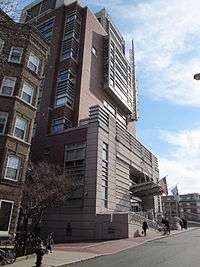 Photonics Center (built 1997)
Photonics Center (built 1997)- Talbot Building, School of Public Health
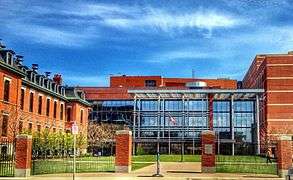 Moakley Building, Boston Medical Center
Moakley Building, Boston Medical Center Instructional building on medical campus
Instructional building on medical campus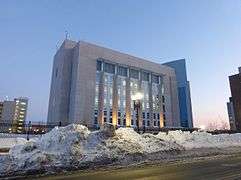
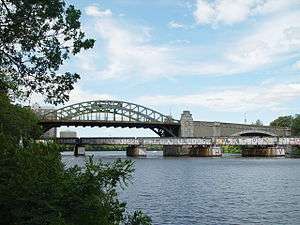
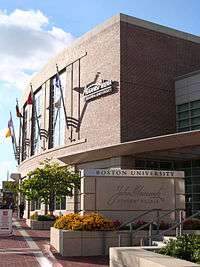
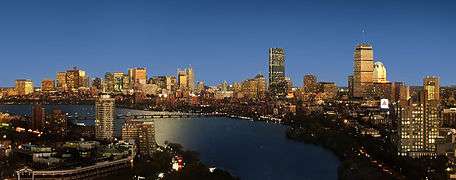 View of Boston from the John Hancock Student Village
View of Boston from the John Hancock Student Village
See also
- Boston University Tanglewood Institute
- Boston University Police Department
- Einstein Papers Project
- Framingham Heart Study
References
- ↑ "The origin of BU's motto: Learning, Virtue, Piety". BU Today. 2005-10-20. Retrieved 2009-11-22.
- ↑ "BU Timeline". Boston University. Retrieved 2015-03-11.
- ↑ Boston University (1898). First quarter centennial of Boston university: Programs and Addresses. Boston: The Riverdale Press. pp. iii.
- ↑ As of June 30, 2015. "U.S. and Canadian Institutions Listed by Fiscal Year (FY) 2015 Endowment Market Value and Change in Endowment Market Value from FY 2014 to FY 2015" (PDF). National Association of College and University Business Officers and Commonfund Institute. 2016.
- 1 2 3 4 5 6 7 "About Boston University". Boston University. Retrieved 2015-03-06.
- ↑ "Boston University Brand Identity Standards" (PDF). Retrieved 2015-06-22.
- ↑ "The College of Fine Arts Introduction". Boston University. Retrieved 2007-06-30.
Boston University is coeducational and nonsectarian.
- ↑ "Boston University Names University Professor Herbert Mason United Methodist Scholar/Teacher of the Year". Boston University. 2001. Archived from the original on December 26, 2010. Retrieved October 20, 2011.
Boston University has been historically affiliated with the United Methodist Church since 1839 when the Newbury Biblical Institute, the first Methodist seminary in the United States was established in Newbury, Vermont.
- ↑ Cambridge University Student Union International 2003–2004. The Hermit Kingdom Press. Retrieved 2007-06-30.
Emory University, an academic institution of higher education that is under the auspices of the United Methodist Church (Duke University, Boston University, Northwestern University are among other elite universities belonging to the United Methodist Church).
- ↑ "The Boston Economy 2008 Holding Strong" (PDF). Boston Redevelopment Authority – Research Division. September 2008. p. 16. Archived from the original (PDF) on July 29, 2012. Retrieved 2009-11-22.
Largest Private Employers in Boston, April, 2006 (With 1,000+ employees, listed alphabetically)
- 1 2 "The Carnegie Classification of Institutions of Higher Education". Indiana University Bloomington's Center for Postsecondary Research. Retrieved September 16, 2015.
- ↑ "The Boston Consortium". The Boston Consortium. Retrieved 2010-05-31.
- ↑ Boston University | Visitor Center | About the University |History Archived February 16, 2006, at the Wayback Machine., retrieved May 6, 2006 Archived February 16, 2006, at the Wayback Machine.
- 1 2 3 4 5 6 Kilgore, Kathleen (1991). Transformations: A History of Boston University. Boston: Boston University Press.
- ↑ Buford, Tom (2006). "Persons in the Tradition of Boston Personalism". The Journal of Speculative Philosophy. 20 (3): 214–218. doi:10.1353/jsp.2007.0000.
- ↑ "Personalism (Stanford Encyclopedia of Philosophy)". Stanford Encyclopedia of Philosophy. Stanford University. Nov 12, 2009.
- ↑ "Between World Wars". Boston University. Archived from the original on December 12, 2007. Retrieved 2008-04-28.
- ↑ Healea, Christopher Daryl, "The Builder and Maker of the Greater University: A History of Daniel L. Marsh's Presidency at Boston University, 1926–1951" (Boston University, 2011). Order No. DA3463124.
- ↑ "10.384 are enrolled at B.U.", The New York Times. April 12, 1936. p. N7.
- ↑ Alex Taylor. "Activism, dorm construction pervade campus in 1950s–60s". The Daily Free Press. Retrieved 2008-04-27.
- ↑ "Lahey History". The Lahey Clinic. Retrieved 2009-12-28.
- 1 2 Wolfe, Tom (February 2015). "Silberado". Bostonia. Boston University: 37.
- ↑ "Life Science and Engineering building: "cathedral to science"". Boston University. Retrieved July 6, 2010.
- ↑ "BU Strategic Plan". Boston University. Retrieved July 6, 2010.
- ↑ "President Launches $1.8 Billion Strategic Initiatives". Boston University. Retrieved July 6, 2010.
- ↑ "MED Buys Site of Future Student Housing". Boston University. Archived from the original on May 1, 2008. Retrieved July 6, 2010.
- ↑ "At Mugar, "a FitRec for the Mind"". Boston University. Archived from the original on March 28, 2010. Retrieved July 6, 2010.
- ↑ BU says campus future is up in the air – News from dailyfreepress.com Archived October 5, 2013, at the Wayback Machine.
- ↑ "BU Bridge. Vol II No. February 24, 19 1998 "BU Yesterday: Third time's the dorm"". Bu.edu. 1999-02-19. Retrieved 2013-10-04.
- ↑ Boston University | Office of Housing | Dining Plans and Convenience Points|Dining Plans, retrieved May 6, 2006 Archived December 12, 2009, at the Wayback Machine.
- ↑ 403 Forbidden Archived March 3, 2006, at the Wayback Machine. accessed May 8, 2006 Archived March 3, 2006, at the Wayback Machine.
- ↑ Salzman, Nancy Lurie. Buildings and builders : a history of Boston University. Boston : Boston University Press, 1985. (ISBN 0-87270-056-9)
- ↑ "BU Pub offers college experience". dailyfreepress.com. April 21, 2004. Archived from the original on October 4, 2013.
- ↑ "Hillel House". Bu.edu. Retrieved 2013-10-04.
- ↑ Harvard Alumni Magazine, "The Welds of Harvard Yard" by associate editor Craig A. Lambert
- ↑ Tomlinson, Sarah (August 27, 2004). "''Boston Globe'', "Rock City revival", August 27, 2004". Boston Globe. Retrieved October 17, 2011.
- ↑ "President Approves New Guest Policy" ~ BU Today May 7, 2007 Archived December 13, 2007, at the Wayback Machine.
- ↑ "New Guest Policy Means More Power, More Responsibility" ~ BU Today March 2, 2007 Archived October 14, 2007, at the Wayback Machine.
- ↑ BU Guest Policy from bu.edu Archived March 25, 2009, at the Wayback Machine.
- 1 2 3 "A Greener BU: Look, Mom, No Trays!". BU Today. Retrieved 2009-06-05.
- ↑ "Survey Rates BU Among Greenest Schools in the Country". Retrieved April 30, 2012.
- ↑ "Study Abroad: Paris". Boston University. Retrieved 2013-08-21.
- ↑ "Washington, DC Housing". Boston University. Retrieved 2013-08-21.
- ↑ "Boston University nears completion". Tonyowenpartners.blogspot.com. October 3, 2010. Retrieved October 17, 2011.
- ↑ "tonyowenpartners: Latest Boston University Shots". Tonyowenpartners.blogspot.com. February 3, 2011. Retrieved October 17, 2011.
- ↑ "Tony Owen Partners | Boston University Student Housing". arthitectural.com. Retrieved October 17, 2011.
- ↑ "Study Abroad". Boston University. Retrieved October 17, 2011.
- ↑ Boston University Brussels – About Us from bu.edu Archived July 6, 2008, at the Wayback Machine.
- ↑ "BU builds dental school in Dubai » Provost, Medical Campus » BUMC". Bumc.bu.edu. 2007-10-18. Archived from the original on March 23, 2008. Retrieved 2010-05-31.
- 1 2 "Profile of Admitted Students". Boston University.
- ↑ "International Students Summary". Boston University. Archived from the original on November 26, 2011. Retrieved 2011-02-01.
- ↑ "Reform Judaism Magazine". Retrieved October 17, 2011.
- 1 2 "Hillel.org". Hillel.org. Retrieved October 17, 2011.
- ↑ "Hillel.org". Hillel.org. Retrieved October 17, 2011.
- ↑ "Freshman Profile". Boston University. Archived from the original on October 5, 2008. Retrieved 2008-08-05.
- ↑ "Boston University alumnus gives $50M gift to school". Boston Herald. Associated Press. March 31, 2015. Retrieved March 31, 2015.
- ↑ "Academic Ranking of World Universities 2016: USA". Shanghai Ranking Consultancy. Retrieved August 16, 2016.
- ↑ "America's Top Colleges". Forbes. July 5, 2016.
- ↑ "Best Colleges 2017: National Universities Rankings". U.S. News & World Report. September 12, 2016.
- ↑ "2016 Rankings - National Universities". Washington Monthly. Retrieved September 6, 2016.
- ↑ "Academic Ranking of World Universities 2016". Shanghai Ranking Consultancy. 2016. Retrieved August 16, 2016.
- ↑ "QS World University Rankings® 2016/17". Quacquarelli Symonds Limited. 2016. Retrieved September 6, 2016.
- ↑ "World University Rankings 2016-17". THE Education Ltd. Retrieved September 21, 2016.
- ↑ "Best Global Universities Rankings: 2017". U.S. News & World Report LP. Retrieved October 25, 2016.
- ↑ "U.S. News Best Colleges Rankings". U.S. News & World Report.
- 1 2 "U.S. News Best Colleges Rankings". U.S. News & World Report.
- ↑ "Top 25 three years running – BU QSB undergraduate program ranked 23rd in Bloomberg Businessweek 2014 rankings". bu.edu. 2014-04-08. Retrieved 2014-04-17.
- ↑ MSN. Retrieved September 18, 2006. Archived August 16, 2010, at the Wayback Machine.
- ↑ "Economic Institution Rankings at IDEAS". RePEc. Retrieved 2013-08-21.
- ↑ "Top Nuclear Engineering Programs | US Graduate Engineering School Rankings | Best Universities in USA | Tuitions 2014". University-list.net. Retrieved 2013-10-04.
- ↑ "Sargent College Facts & Statistics". Bu.edu. Retrieved 2013-10-04.
- ↑ "The Hollywood Reporter Unveils the Top 25 Film Schools of 2013". Hollywoodreporter.com. 2013-07-31. Retrieved 2014-08-14.
- ↑ "2011 Undergrad B-School Rankings". Images.businessweek.com. March 9, 2011. Archived from the original on November 26, 2013. Retrieved 2013-10-04.
- ↑ "2010 Full time MBA ranking". The Economist. 2010-10-15. Retrieved September 17, 2011.
- ↑ "Business school rankings from the Financial Times - Global MBA Rankings 2011". Rankings.ft.com. Retrieved 2013-10-04.
- ↑ "quantnet.com / Business Education". Retrieved January 12, 2012.
- ↑ "Boston University School of Social Work Rankings". Retrieved 2016-03-24.
- ↑ "The Top American Research Universities: 2010 Annual Report" (PDF). 2010. Retrieved September 17, 2011.
- ↑ Freedman, Samuel G. (2006-06-07). "Can Tough Grades Be Fair Grades?". The New York Times. p. B8. Retrieved 2006-06-07.
- ↑ Rojstaczer, Stuart (March 10, 2009). "Grade Inflation Across the U.S.". Boston University. gradeinflation.com. Retrieved 2012-05-13.
- ↑ Rojstaczer, Stuart (March 10, 2009). "Grade Inflation Across the U.S.". Boston University. gradeinflation.com. Retrieved 2012-05-13.
- ↑ Rojstaczer, Stuart (March 10, 2009). "Grade Inflation Across the U.S.". Amherst College. gradeinflation.com. Retrieved 2012-05-13.
- ↑ Rojstaczer, Stuart (March 10, 2009). "Grade Inflation Across the U.S.". New York University. gradeinflation.com. Retrieved 2012-05-13.
- ↑ Rojstaczer, Stuart (March 10, 2009). "Grade Inflation Across the U.S.". Harvard University. gradeinflation.com. Retrieved 2012-05-13.
- ↑ Berdik, Chris (2006-09-14). "Grade Deflation or Not?". BU Today. Archived from the original on October 14, 2007. Retrieved 2006-10-06.
- ↑ "BU Law - Prospective Students J.D. Program". Retrieved 2010-07-26.
- ↑ "Journal of Education". Retrieved 2010-07-26.
- ↑ "Boston University Arts & Sciences". Retrieved 2010-07-26.
- ↑ "Index for JFA". Retrieved 2010-07-26.
- ↑ "Maney Publishing Journal of Field Archaeology". Retrieved 2010-07-26.
- ↑ rs. "The Historical Society, Boston University". Bu.edu. Retrieved 2013-10-04.
- ↑ "Research at the College of Communication". Archived from the original on May 5, 2010. Retrieved 2010-07-26.
- ↑ "New England Center for Investigative Reporting at Boston University". Retrieved 2010-07-26.
- ↑ "WR: Journal of the CAS Writing Program » Writing Program » Boston University". Bu.edu. Retrieved 2013-10-04.
- ↑ "Boston University – UNI Program". Retrieved 2007-09-24.
- ↑ "What is Kilachand Honors College? » Kilachand Honors College | Boston University". Bu.edu. Retrieved 2013-04-22.
- ↑ "Boston Political Review". Retrieved 2016-06-10.
- ↑ "The Quad, BU's independent online magazine". buquad.com. Retrieved 2010-05-31.
- ↑ "BU Synapse Website". Bu.edu. October 12, 2011. Retrieved October 17, 2011.
- ↑ http://www.bu.edu/studentactivities/2014/02/10/bu-literary-society-launches-inaugural-issue/
- ↑ "Boston University – Division of Military Education". Bu.edu. Retrieved 2013-10-04.
- ↑ "Boston University – Nu Mu Chapter". Bu.edu. Retrieved 2013-10-04.
- ↑ "Bhangra Dance Group". Archived from the original on April 3, 2015. Retrieved 2016-06-10.
- ↑ "Peer Health Exchange – PHE Sites". Peerhealthexchange.org. Archived from the original on September 9, 2011. Retrieved October 17, 2011.
- ↑ About Us » Curling Club | Boston University. Sites.bu.edu. Retrieved on 2013-11-24.
- ↑ web site for Boston Model UN VIII
- ↑ "web site". United Nations. Retrieved October 17, 2011.
- ↑ "Student Activities Office Web site about Fraternity/Sorority activities". Bu.edu. June 3, 2011. Archived from the original on November 26, 2011. Retrieved October 17, 2011.
- ↑ Barlow, Rich (March 22, 2012). "Alleged Sorority Hazing Investigated by University, Police: Sigma Delta Tau suspended during probe". BU Today.
- ↑ Jahnke, Art (April 11, 2012). "Fourteen Are Charged With Hazing: Victims were found with welts on their backs". BU Today.
- ↑ "Boston University student died from lethal amount of alcohol: Anthony Barksdale died at fraternity party". WCVB. March 8, 2013.
- ↑ "Welcome-Sigma Kappatest". Bu.sigmakappa.org. 1904-04-19. Retrieved 2013-10-04.
- ↑ "Boston University accepts bid to join Patriot League starting in 2013-2014". Patriot League General Release. Patriot League. Retrieved 15 June 2012.
- ↑ "National Collegiate Athletic Association". Ncaa.com. Retrieved October 17, 2011.
- ↑ Marrapese-Burrell, Nancy (2010-01-09). "Great outdoors – The Boston Globe". Boston Globe. Retrieved 2010-05-31.
- ↑ Hanson, Gayle M.B. & Berg, Stacie Zoe. Long on losses, short on funds, BU football lets clock run out. Insight on the News (Dec 15, 1997).
- ↑ "About | BU Dinghy Sailors". Budinghysailors.wordpress.com. Retrieved 2013-04-22.
- ↑ "Shortlist Announced for US Sailing's Rolex Yachtsman & Yachtswoman of the Year". Media.ussailing.org. Archived from the original on May 12, 2013. Retrieved 2013-04-22.
- ↑ "The National Champions You Might Not Know". Bostonia. Bu.edu (Summer 2009). July 24, 2009. Retrieved October 17, 2011.
- ↑ The Concise Columbia Encyclopedia (Second ed.). New York: Columbia University Press. 1989. p. 437.
- ↑ "The Legacy of Howard Thurman: Mystic and Theologian" (Religion and Ethics Newsweekly). PBS. January 18, 2002. Retrieved 25 June 2014.
- ↑ "About BU: Fast Facts | Boston University Admissions". Bu.edu. May 5, 1922. Retrieved October 17, 2011.
- ↑ Kohanski, MA; DePristo MA; Collins JJ. (2010). "Sublethal antibiotic treatment leads to multidrug resistance via radical-induced mutagenesis.". Molecular Cell. 37 (3): 311–320. doi:10.1016/j.molcel.2010.01.003. PMC 2840266
 . PMID 20159551.
. PMID 20159551. - 1 2 3 4 "Award Winning Faculty". Boston University Research. Boston University Office of the Vice President and Associate Provost for Research. Retrieved 25 June 2014.
- ↑ Candor, Austin. "Professor of the week: Scott Perkins". Retrieved 17 June 2015.
- ↑ "André de Quadros » College of Fine Arts | Boston University". Bu.edu. October 13, 2011. Retrieved October 17, 2011.
- ↑ McQuaid, Cate (December 3, 2014). "BU's abstract ace shows his stripes". The Boston Globe.
- ↑ "Pulitzer Winners". Boston University College of Communication. Boston University. Archived from the original on February 19, 2015. Retrieved October 12, 2015.
- ↑ "Faculty » College of Communication » Boston University". Bu.edu. Archived from the original on April 14, 2010. Retrieved October 17, 2011.
- ↑ "Andrew J. Bacevich » International Relations | Boston University". Bu.edu. Retrieved October 17, 2011.
- ↑ "WVU Libraries: Isaac Asimov Online Exhibit". Libraries.wvu.edu. Archived from the original on September 28, 2011. Retrieved October 17, 2011.
- ↑ Ricks, Christopher, ed. (1999). Oxford Book of English Verse. Oxford University Press.
- ↑ Feeney, Mark; Marquard, Bryan (2010-01-27). "Howard Zinn, historian who challenged status quo, dies at 87". The Boston Globe.
- ↑ Biography, retrieved 4 September 2014
- ↑ "BU School of Law Timeline". Boston University. Retrieved 16 January 2014.
- ↑ Ryan, Andrew; Bombardieri, Marcella (12 November 2013). "Menino to help start urban institute at BU". The Boston Globe.
- 1 2 Leving, Jessica (June 4, 2009). "Bill O'Reilly's BU Days". Boston University. BU Today. Retrieved 25 June 2014.
- ↑ "GORDON HYATT". Television Quarterly. National Academy of Television Arts and Sciences. 2. 1963.
- ↑ Altschiller, Donald. "Music lyrics with a Boston theme". Boston University Libraries. Boston University. Retrieved 26 June 2014.
- ↑ Dailey Free Press, February 27, 2007 Actor, producer Spacey brings filming to BU Castle
- ↑ Penner, James. "The Good Friday Experiment" Timothy Leary: The Harvard Years: Early Writings on LSD and Psilocybin with Richard Alpert, Huston Smith, Ralph Metzner, and others, 21 July 2014. Retrieved on 12 February 2016.
Further reading
| Wikisource has the text of the 1920 Encyclopedia Americana article Boston University. |
- Kilgore, Kathleen (1991). Transformations: A History of Boston University. Boston: Boston University Press. ISBN 0-87270-070-4.
- Saltzman, Nancy (1985). Buildings and Builders: An Architectural History of Boston University. Boston: Boston University Press. ISBN 0-87270-056-9.
External links
| Wikimedia Commons has media related to Boston University. |
- Official website
- Boston University Athletics website
-
 "Boston University". The New Student's Reference Work. 1914.
"Boston University". The New Student's Reference Work. 1914. -
 "Boston University". Encyclopedia Americana. 1920.
"Boston University". Encyclopedia Americana. 1920. -
 "Boston University". Collier's New Encyclopedia. 1921.
"Boston University". Collier's New Encyclopedia. 1921.
Coordinates: 42°20′59″N 71°05′59″W / 42.3496°N 71.0997°W
.jpeg)

_by_Erling_Mandelmann_-_2.jpg)